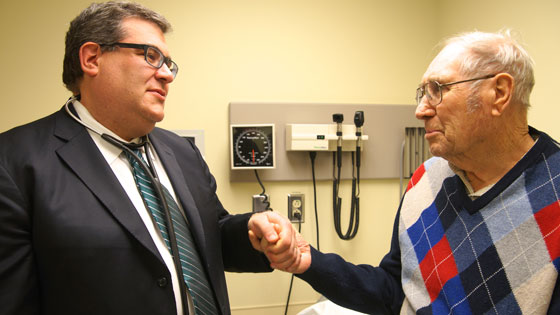
Dr. Eric Horlick (left), Cardiologist, Peter Munk Cardiac Centre, shares a poignant moment with David McCallum, the first patient in Ontario to undergo a heart valve replacement procedure while awake. McCallum, 87, underwent the “awake TAVI,” or transcatheter aortic valve implantation procedure, in January. (Photo: UHN)
"I couldn't do anything. It was debilitating." David McCallum doesn't mince his words.
Several years after having two stents inserted, the Scarborough resident's heart was in trouble again.
"I got an angiogram and it showed the aortic valve was defective," he says. "Walking down to the basement and coming back upstairs was difficult. It lasted for months."
McCallum's only option was a TAVI, or transcatheter aortic valve implantation procedure.
TAVIs are performed on patients suffering from severe aortic stenosis. This condition occurs when the heart's aortic valve is prevented from opening completely. The narrowing of the aortic valve prevents blood flow from the heart to the rest of the body. It results in the heart working harder to pump blood, which could lead to a host of serious heart conditions and, in the worst cases, death.
First procedure done in January
As the site where TAVI in Ontario was born in 2007, the Peter Munk Cardiac Centre has taken the minimally-invasive operation to new heights.
Until recently, patients undergoing a TAVI procedure at Canada's premier cardiac centre would be put under general anaesthesia. All of that changed on January 16, 2015.
That's the day David McCallum made history. The 87-year-old became the first patient in Ontario to undergo a TAVI procedure – awake – with no anaesthesia.
"There has been a lot of evolution in this procedure, and we've gained a tremendous amount of experience in performing this procedure," says Dr. Eric Horlick, Cardiologist and Director of the Adult Structural Heart Disease Program at the Peter Munk Cardiac Centre.
Dr. Horlick was part of the medical team that led the first awake TAVI, as it has been dubbed. "For us it was just a natural evolution to proceed to doing these types of procedures without a general anaesthetic," he says.
Dr. Eric Horlick, Cardiologist and Director of the Adult Structural Heart Disease Program at the Peter Munk Cardiac Centre, explains the “awake TAVI,” which he performed for the first time in Ontario in January.
(Photo: UHN)
Faster recovery, earlier discharge
"When Dr. Horlick asked me what I expected from the operation, I said, 'I expect to come out the other end,'" quips McCallum, who never for a second questioned the idea of having the procedure without anaesthesia. "You put yourself in a man's hands who knows what he's doing. I said, 'go ahead, mate. Do your best,'" smiles McCallum.
Dr. Chris Feindel, cardiac surgeon at the Peter Munk Cardiac Centre, adds: "eliminating the need for a general anaesthetic results in faster recovery and earlier discharge from the hospital, and this is particularly so for the sicker patients."
In just over two months, PMCC TAVI teams have performed more than a dozen "awake TAVIs." The average age of these patients was 82 years old.
"An important message would be that age is not a barrier to TAVI," says Kathy Svitak, TAVI Nurse Coordinator at the Peter Munk Cardiac Centre.
Related to this story:
AWAKE DURING A MEDICAL PROCEDURE
Awake TAVI facts:
- Local anaesthetic is used at the insertion site in leg.
- Sedation is administered and monitored by the anaesthetist.
- Fewer lines are inserted such as breathing tube, echo probe in the swallowing tube, foley catheter to drain urine. Less invasive lines decrease the risk of complications of procedure
- Decreased procedure time by one hour or more due to inserting fewer lines
- Decreased risk of delirium after procedure
- Decreased length of stay in hospital. (Patients are individualized for length of stay depending on deconditioned state coming into procedure)
Benefits of an awake TAVI:
- Promotes a safe and rapid recovery
- Goals: Increasing mobility, stability and continence
- Decrease cognitive impairment
- Promote a safe discharge home with an uncomplicated recovery and rapid return to baseline status
- Optimize self-care capacity
Wheeled into the Multi-Purpose Operating Room (MPOR) where the TAVI was performed, McCallum describes what was going through his mind. "I was quite awake. I started to look around. All the equipment that was in that room, how the world has changed since I was a boy.
"I would have been dead years ago, but for modern medicine."
"It takes about 25-30 minutes," says Dr. Horlick. "No urinary catheter, no extras are required.
"We just try and get people through the procedure so that we can get them out of hospital quickly and get them back to their lives."
Dr. Feindel adds that while beneficial for a host of reasons, an awake TAVI may not always be the best option. "In the right patient, awake TAVI, or 'conscious sedation,' has very definite advantages.
"Better techniques to place the valve through a catheter without having to surgically open the artery, along with the use of newer sedating drugs which eliminate the need for a full general anaesthetic have allowed us to move forward."
"Painless, recovery was easy"
For the provinces' first awake TAVI patient, the experience ran as smoothly as possible.
"It was painless. The recovery was easy," says McCallum.
Part of the information that patients are provided prior to undergoing a TAVI is a summary of what they may encounter. It is during this session that nurse Svitak introduces patients to the new option of undergoing the procedure with only local anaesthesia – at the site in the leg where the catheter is inserted.
To date, Svitak says not one patient has declined the option of having an awake TAVI.
"I think I was damn lucky at my age," says David McCallum. "It's good for your soul to know you can survive these types of things."
